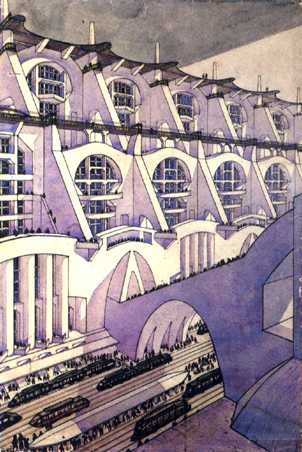|
Sant'Elia
Marinetti
Boccioni
Prampolini
Balla
Depero
Chiattone
Marchi
Aloisio
Baldessari
Djulgheroff
De
Giorgio
Dottori
Costa
Crali
Fillia
Fiorini
Mazzoni
Mosso
Paladini
Pannaggi
Poggi
Sartoris
Thayaht
Busiri-Vici
Libera
Mattč-Trucco
Portaluppi
Terragni
...altri
|
Esponente di spicco del
Secondo Futurismo, nonchč uno dei maggiori scenografi italiani, si
accosta ai futuristi nell'immediato primo dopoguerra, e nel 1920 firma
il Manifesto
dell'architettura futurista dinamica stato d'animo, drammatica.
Inizia la sua attivitą creativa progettando spazi scenici ed espositivi
entrati nella storia delle avanguardie (Casa d'Arte Bragaglia, lo
Sperimentale) mentre i primi anni '30 siglano l'inizio della la sua
carriera di scenografo cinematografico, lavorando con Trenker, Blasetti
e - nel dopoguerra - firmando famosi film neorealisti con Rossellini,
Vittorio De Sica, ecc.
Autore di una copiosa produzione saggistica, teorica e didattica - dai
primi articoli e manifesti su riviste e pubblicazioni futuriste fino a
trattati sulla scenografia teatrale e cinematografica - oltre a molte
pagine poetiche, letterarie e memorialistiche, nei suoi scritti
futuristi ripropone una concezione dell'architettura
espressionisticamente intesa come "scultura abitabile", da
contrapporre polemicamente alla "macchina per abitare" dei
razionalisti.
 Anonimo,
FOTO DI GRUPPO CON V. MARCHI [particolare] (anni '20) pa
An oustanding personality of the second wave of Futurism, and one of the
most outstanding Italian theatre set designers, Marchi made contact with
the Futurists immediately after the end of the First World War and then
in 1920 he signed theManifesto
of Dynamic, instinctive, Dramatic Futurist Architecture. Anonimo,
FOTO DI GRUPPO CON V. MARCHI [particolare] (anni '20) pa
An oustanding personality of the second wave of Futurism, and one of the
most outstanding Italian theatre set designers, Marchi made contact with
the Futurists immediately after the end of the First World War and then
in 1920 he signed theManifesto
of Dynamic, instinctive, Dramatic Futurist Architecture.
He started his creative work designing theatrical and exhibition spaces
which were to become part of the history of all the avant-gardes (such
as his Bragaglia Art House or the "Sperimentale"theatre);
later, in the early Thirties, he began to work as a cinema set designer
and worked with directors like Trenker and Blasetti and, after 1945, as
a co-founder of the world-famous Neorealist School with Roberto
Rossellini, Vittorio De Sica, and others.
Prolific as an essayist, theoretician and teacher, his earliest articles
and manifestoes in magazines and Futurist publications led on to
treatises that dealt with set design for the theatre and the cinema, and
numerous works of poetry, memoirs, and other writings.
His writings as a Futurist included the proposal of an architecture
which in its mode of expression was intended as "habitable
sculpture" in deliberate polemic with the "machine for living
in" concept of the Rationalists.

Cittą (anni
'30) ff
Direttamente ispirato alle visioni urbane di Sant'Elia, questa
raffigurazione rappresenta nell'ambito della produzione di Marchi uno
degli esempi maggiormente 'ortodossi' dal punto di vista costruttivo.
This image,
directly inspired by the urban visions of Sant'Elia, was one of the more
"realistic" examples produced by Marchi so far as practical
construction was concerned.
City
(about 1930)
|
|
pagine
web selezionate
selected
web pages
|
|
|
|
|
|